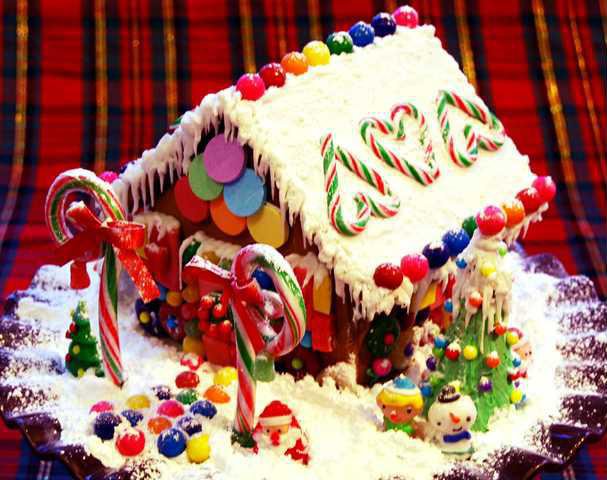Food is intrinsically linked to holiday celebrations. Christmas has many layers of traditions related to food: gingerbread, candy canes and a few you may not know about. Here is a history of some of our beloved food-related Christmas traditions.
Gingerbread houses
Gingerbread cookies were popular in Elizabethan England. Gingerbread men were known as gingerbread husbands (if only all men could be so sweet), and it was the British settlers who brought gingerbread to America, according to "The History of Gingerbread" on pbs.org. The Germans gave us the first gingerbread houses. Sometime during the 16th century, the same era in which Martin Luther introduced candlelit Christmas trees, the bakers in Germany began creating fancy gingerbread cookie houses adorned with foil and gold leaf. When the Brothers Grimm penned the story of Hansel and Gretel with the cottage in the wood made of gingerbread, the edible architectures' popularity exploded, although it is not known which came first art or life.
A gingerbread house of nearly 40,000 cubic feet was built in Texas and certified as the largest in 2013, according to People.com. A building permit was necessary to construct the 4,000-gingerbread-brick structure, which required 1,800 pounds of butter, over 11 pounds of ginger and 22,000 pieces of candy.
Sweetness and light
Readers in the Beehive State might be interested to know that honey, bees and beehives were medieval Christmas themes, according to medieval expert and scholar Madeleine Pelner Cosman, author of "Medieval Holidays and Festivals." To ancestors of days long ago, the honeybee was a symbol of Christmas due to its role as a provider of sweetness and light, Cosman shares in "Medieval Holidays and Festivals." Bees make honey and honeycomb, which yields beeswax from which candles can be made. These things represent the good gifts of God, especially the candles giving forth light through the long nights of winter, reminding people of the Babe of Bethlehem, the Light of the World.
Candy canes
Legend says that a choirmaster in Cologne, Germany, had white candy shepherds' crooks manufactured for his children's choir to keep them quiet during services in 1670, according to "History of Christmas" at history.com. In the early 20th century, an Indiana candy manufacturer added peppermint flavoring and red stripes to make the sweets more interesting. According to history.com, one candy company makes 1.5 million candy canes every day of the year.
Oranges and chocolate coins in stockings
When St. Nicholas learned that the oldest daughter of a family wished to be married but was held back by her lack of a dowry, he secretly placed gold coins in her stockings that were hanging to dry, according to "The Legend of the Christmas Stocking" on smithsonianmag.com. Happily surprised by the windfall, the next two daughters also hung their stockings and were obliged by the saint. Today, children often wake on Christmas morning to find in their stockings oranges that represent gold, or chocolate coins wrapped in gold foil, according to smithsonianmag.com.
Gingerbread houses
Gingerbread cookies were popular in Elizabethan England. Gingerbread men were known as gingerbread husbands (if only all men could be so sweet), and it was the British settlers who brought gingerbread to America, according to "The History of Gingerbread" on pbs.org. The Germans gave us the first gingerbread houses. Sometime during the 16th century, the same era in which Martin Luther introduced candlelit Christmas trees, the bakers in Germany began creating fancy gingerbread cookie houses adorned with foil and gold leaf. When the Brothers Grimm penned the story of Hansel and Gretel with the cottage in the wood made of gingerbread, the edible architectures' popularity exploded, although it is not known which came first art or life.
A gingerbread house of nearly 40,000 cubic feet was built in Texas and certified as the largest in 2013, according to People.com. A building permit was necessary to construct the 4,000-gingerbread-brick structure, which required 1,800 pounds of butter, over 11 pounds of ginger and 22,000 pieces of candy.
Sweetness and light
Readers in the Beehive State might be interested to know that honey, bees and beehives were medieval Christmas themes, according to medieval expert and scholar Madeleine Pelner Cosman, author of "Medieval Holidays and Festivals." To ancestors of days long ago, the honeybee was a symbol of Christmas due to its role as a provider of sweetness and light, Cosman shares in "Medieval Holidays and Festivals." Bees make honey and honeycomb, which yields beeswax from which candles can be made. These things represent the good gifts of God, especially the candles giving forth light through the long nights of winter, reminding people of the Babe of Bethlehem, the Light of the World.
Candy canes
Legend says that a choirmaster in Cologne, Germany, had white candy shepherds' crooks manufactured for his children's choir to keep them quiet during services in 1670, according to "History of Christmas" at history.com. In the early 20th century, an Indiana candy manufacturer added peppermint flavoring and red stripes to make the sweets more interesting. According to history.com, one candy company makes 1.5 million candy canes every day of the year.
Oranges and chocolate coins in stockings
When St. Nicholas learned that the oldest daughter of a family wished to be married but was held back by her lack of a dowry, he secretly placed gold coins in her stockings that were hanging to dry, according to "The Legend of the Christmas Stocking" on smithsonianmag.com. Happily surprised by the windfall, the next two daughters also hung their stockings and were obliged by the saint. Today, children often wake on Christmas morning to find in their stockings oranges that represent gold, or chocolate coins wrapped in gold foil, according to smithsonianmag.com.





